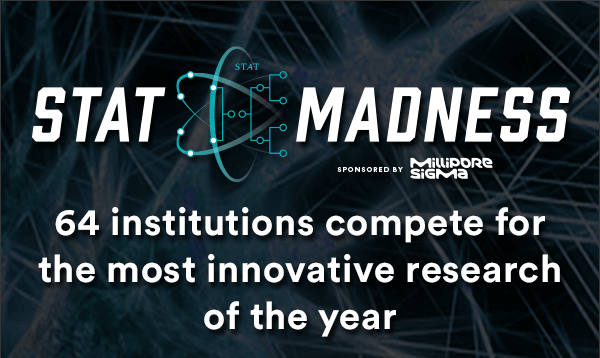
|
Two research teams from UMass Medical School have been selected by STAT News to compete among 64 contestants in the 2020 STAT Madness competition. STAT Madness is a bracket-style competition in which members of the public vote for the best biomedical research from 2019. The first round of voting begins on Monday, March 2.
Published in Nature Communications in July 2019, the first UMMS research study identified a promising gene therapy that could promote bone formation in people with osteoporosis. UMMS researchers on the paper, included Yeon-Suk Yang, manager in the Bone Analysis Core; Jae-Hyuck Shim, PhD, associate professor of medicine and director of the Bone Analysis Core; and Guangping Gao, the Penelope Booth Rockwell Professor in Biomedical Research, professor of microbiology & physiological systems, director of the Horae Gene Therapy Center and co-director of the Li Weibo Institute for Rare Diseases Research. After identifying the Schnurri-3 (SHN3) gene as a promising therapeutic target for osteoporosis, the team demonstrated that systemic delivery of a SHN3 artificial-microRNA via a bone-homing adeno-associated virus (AAV) vector, promoted new bone formation and reversed bone loss in a mouse model of osteoporosis, while enhancing the mechanical properties of bone in clinically meaningful ways.
Anastasia Khvorova, PhD, professor of RNA therapeutics, along with postdoctoral associates Julia F. Alterman, PhD; Bruno Miguel da Cruz Godinho, PhD; Matthew R. Hassler, PhD; and Chantal M. Ferguson, MD/PhD student in the School of Medicine and Graduate School of Biomedical Science, co-authored the second study selected for STAT Madness. Published in Nature Biotechnology in August 2019, the research describes a novel chemical structure for delivering siRNAs developed by the Khvorova lab. This design, called di-siRNA, allows for potent and sustained gene silencing throughout the central nervous system. A divalent structure, the di-siRNA consists of two chemically modified and stabilized siRNAs linked together. The cooperative interactions between the two siRNA molecules facilitate cell uptake while being less “sticky” than hydrophobic siRNA molecules, which are retained at the injection site. An injection of di-siRNA targeting the Huntington’s disease gene in both mouse models and nonhuman primates achieved broad distribution in the brain, and up to 95 percent reduction in huntingtin protein for up to six months without causing toxicity. This technology raises hope that siRNA drugs could be developed to treat a wide range of neurological disorders.
The public is encouraged to vote on its favorite research teams beginning on Monday, March 2. To sign up for a reminder about voting, click here. The winning research team will be named in early April after six rounds of voting. Follow the competition on Twitter, Facebook and LinkedIn.
Related stories on UMassMedNow:
Two UMass Medical School research teams named STAT Madness 2019 contenders
UMass Medical School innovation chosen for ‘STAT Madness’ contest